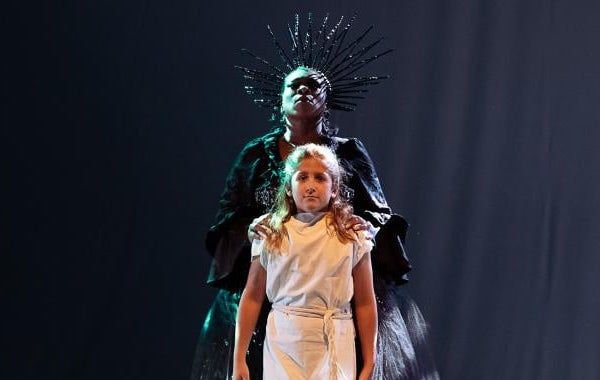Ars Minerva: Astianatte
Jasmine Johnson as Andromaca in Leonardo Vinci's Astinatte, produced by Ars Minerva at ODC Theater, San Francisco, October 21-23, 2022. Photo credit: Valentina Sadiul. Image source: OperaWire
Leonardo Vinci's 1725 opera Astianatte (Astyanax) is packed with high drama. Antonio Salvi's libretto, adapted from Racine's tragedy Andromaque (1667), is set in the immediate aftermath of the Trojan war. Andromaca (Andromache) and her young son Astianatte have been abducted by the victorious Greeks. They are held captive by Pirro (Pyrrhus), the son of the Greek hero Achilles; Achilles slew the Trojan warrior Hector, Andromaca's husband and Astianatte's father.
Pirro is betrothed to Ermione (Hermione), but wants Andromaca instead. Ermione's former lover Oreste (Orestes) arrives with a message for Pirro from Ermione's father Menelaus: kill Astianatte to prevent him from growing up to take revenge against the Greeks. The only way Andromaca can protect Astianatte is to marry Pirro, the son of her husband's killer and a man she hates.
Jasmine Johnson as Andromaca and Anthony Polakoff as Astianatte. Photo credit: Valentina Sadiul. Image source: San Francisco Classical Voice
Meanwhile, although Oreste is still in love with Ermione, he must also deliver Menelaus' demand that Pirro wed her immediately or return her to Sparta. Backing up Menelaus' ultimatums, of course, is the threat of war. Ermione, stung that Pirro prefers an enslaved Trojan widow to a daughter of Helen, demands that Oreste revenge the slight against her honor.
Nikola Printz as Oreste and Aura Veruni as Ermione. Photo credit: Valentina Sadiul.
Vinci wrote Astianatte for four of the greatest singers in the world: the soprano castrato Farinelli (Oreste), contralto Diana Vico (Pirro), soprano Anna Maria Strada (Ermione), and contralto Vittoria Tesi (Andromaca), the first Black prima donna. Astianatte is a silent role, making this perhaps the only opera named after a character that doesn't sing. Any company seeking to revive it needs four superlative singers—a requirement that Ars Minerva decidedly fulfilled, thanks to Céline Ricci's ability to attract first-rate vocal talent to her projects.
Jasmine Johnson brought to the role of Andromaca a regal stage presence, fierce dramatic conviction, and an astonishing voice with a strikingly wide range. All her abilities were showcased in her great scenes, including her furious rejection of the importunate Pirro in Act I and her farewell to her son Astianatte that opens Act II. Johnson's thrilling descents into her deep lower register added dramatic bite to her exchanges, but along with powerful feeling she also sang with great beauty.
As Pirro, Deborah Martinez Rosengaus surmounted the daunting vocal challenges of the role with apparent ease, and managed to elicit sympathy for the character despite his willingness to murder Astianatte (the execution is thwarted at the last moment).
Deborah Martinez Rosengaus as Pirro, Anthony Polakoff as Astinatte, and Aura Veruni as Ermione. Photo credit: Valentina Sadiul. Image source: San Francisco Classical Voice
Nikola Printz brought swaggering, Elvis-like energy, the athleticism of an aerialist, and a powerful voice to the volatile Oreste. Portraying perhaps the least sympathetic character, the vengeful Ermione, Aura Veruni's strong performance and attractive voice helped us perceive the wounded nobility of the Greek princess, who is, after all, being used by her father as a sexual pawn in a game of political power. Jayne Diliberto and Daphné Touchais made the most of their opportunities in the supporting roles of Clearte (Pirro's loyal confidant) and Pilade (Oreste's ally). Astianatte was performed movingly by Anthony Polakoff.
The vocalists were richly supported by a 14-piece period instrument orchestra led by conductor Matthew Dirst and concertmaster Cynthia Keiko Black. 18th-century operas have an false reputation as a unvarying succession of da capo arias. In Astianatte Vinci's arias are often relatively short, tuneful, and flexible, as is seen in Andromaca's first-act aria in which her sorrowful addresses to her son are interrupted by her angry asides to Pirro.
Entropy's projections and Delayne Medoff's lighting design effectively suggested the different spaces of the opera (interiors, a garden, a temple, and the port with Pirro's ships aflame).
Projection by Entropy and lighting by Delayne Medoff for the Temple of Juno. Image source: @Celine_Ricci
Marina Polakoff's stunning sculptural costume designs were gradually revealed by Céline Ricci's clever staging, which introduced the characters in a dressing room and over the course of the opera revealed them donning in full both their elaborate costumes and their complex characters.
Astianatte was the most ambitious staging yet by Ars Minerva, which surpasses itself with every production. I'm eager to see what the company will do next.
Update 25 November 2022: Astianatte was named as one of my Favorites of 2022: Live and streamed performances

















No comments :
Post a Comment